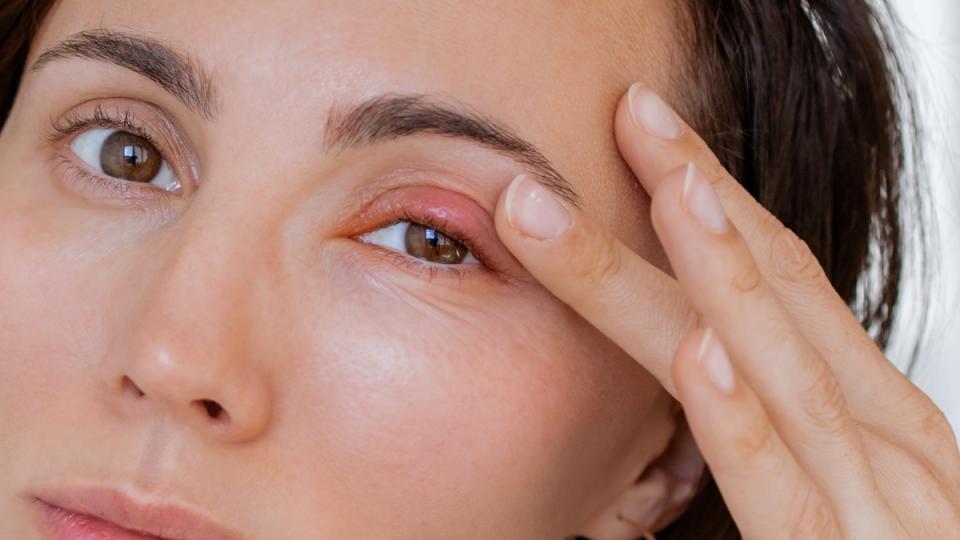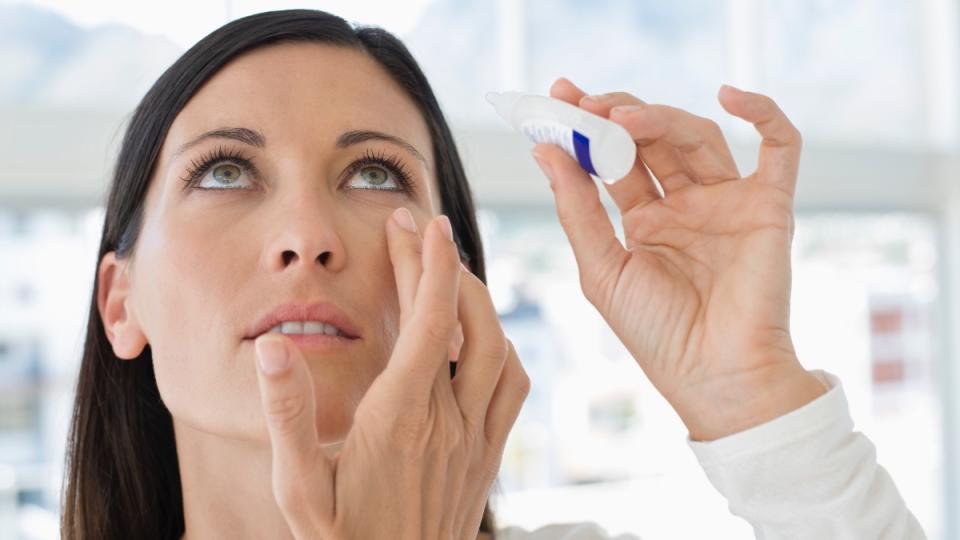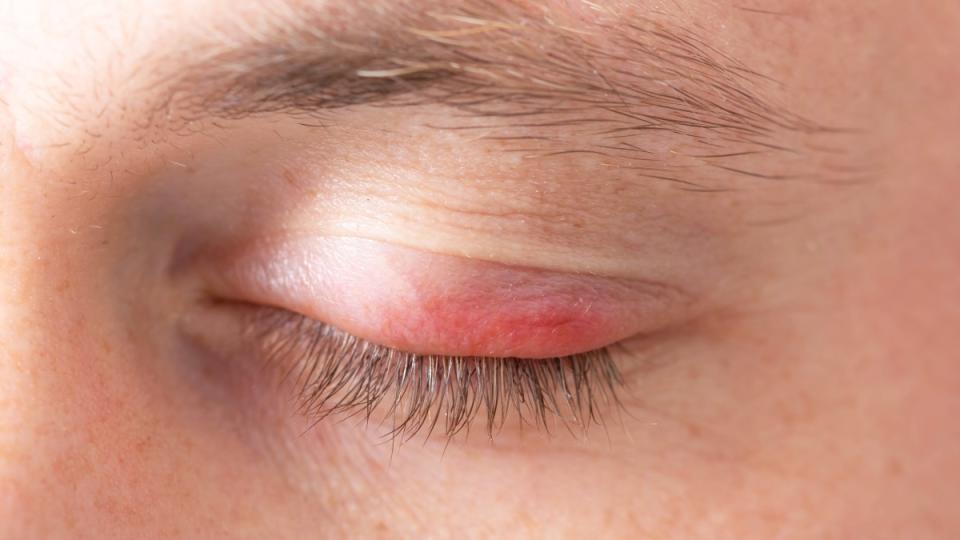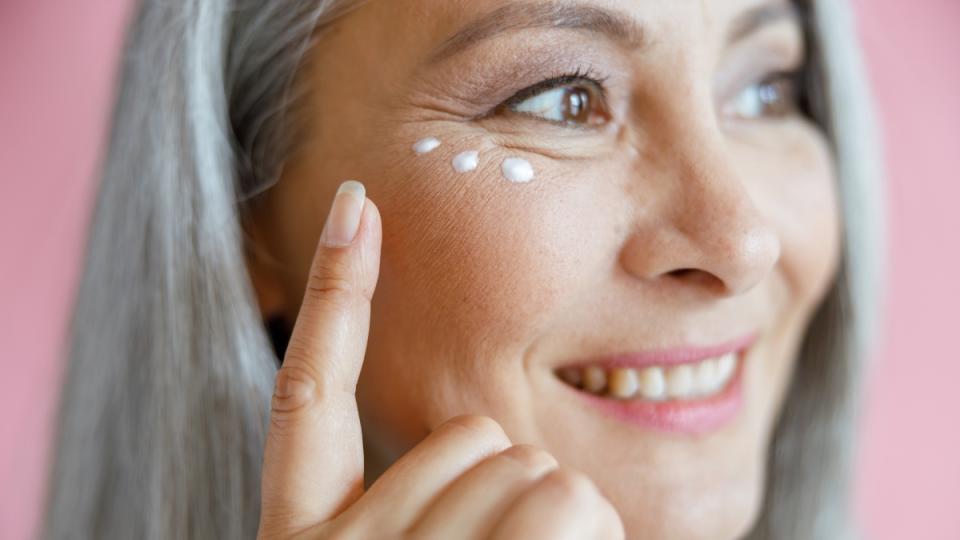Eye Docs Share the Fastest Way To Heal a Swollen Eyelid + the Warning Sign To Watch Out For
Most of us have woken up with a puffy eyelid at some point in our lives. Aside from being uncomfortable (and sometimes painful), it can also temporarily affect your vision. When that happens, you’ve probably wondered what caused it and what is the fastest way to heal a swollen eyelid?
“Eyelid swelling can encompass a variety of conditions that include real disease but also even normal eyelid changes,” explains Brittany Simmons, MD, a specialist in oculofacial plastic, orbital and reconstructive surgery at the Kellogg Eye Center at the University of Michigan.
That means the fastest way to heal a swollen eyelid actually depends on the source of the swelling. Here, we break down the most common culprits and speedy remedies.
Common causes of a swollen eyelid + easy cures
While swollen eyelids can be frustrating, they’re generally not cause for concern. In most cases, eyelids swell due to benign conditions and can be easily remedied at home. If you notice puffiness, it's likely due to one of these triggers.
1. A stye
Styes, also known as chalazion or hordeolum, are one of the most common causes of eyelid swelling. They usually appear as a small bump along the edge of the upper or lower eyelid.
“They start out as a blocked oil gland that causes inflammation, and that inflammation causes a hard red bump,” Dr. Simmons says. “You may have some foreign body sensation on the eye. Or you may see it looking like it's coming to a head — almost like a whitehead or a pimple.”

The fastest way to heal a swollen eyelid caused by a stye
If a stye is behind your swollen eyelid, Dr. Simmons says applying a warm compress to the affected area for 10 to 15 minutes, three to five times a day helps heal a stye by removing the blockage. And while a simple warm washcloth will do the trick, you can also use a warm, damp green tea bag if you have one handy. Why? Green tea brims with antimicrobial properties that help speed healing plus soothe inflammation. (Click through for more ways to get rid of a stye.)
2. Allergies or allergic reactions
Seasonal allergies and allergic reactions to soaps or makeup can lead to a swollen eyelid. This type of irritation and swelling is known as allergic conjunctivitis. (Not to be confused with the viral infection that causes pink eye.)
“With seasonal allergies, usually you'll also have some eye surface symptoms," Dr. Simmons says. "The eyes will feel itchy or irritated." You may also notice puffy eyelids in the morning, when detergents from bedsheets or pollen from open windows had ample time to irritate your eyes overnight.
Related: These Teas Ease Allergies Naturally + the Timing Trick That Boosts the Benefit
The fastest way to heal a swollen eyelid caused by an allergic reaction
For seasonal allergy-induced eyelid swelling, Dr. Simmons suggests three easy steps. “Very conservative things will help manage it,” she says. “Try cool compresses, take an over-the-counter allergy medicine and maybe some anti-itch drops for the eyes.”
Cool compresses can be applied for 15 minutes every few hours. To boost the benefit, consider using antihistamine eye drops such as Systane, Alaway and Pataday in addition to oral OTC allergy meds.

If you suspect an allergic reaction could be behind the inflammation, look at whether you’ve started using a new soap or skincare product. And check that your makeup and other products you use on your eye area haven’t expired.
“Think about what you use — anything new or makeup that’s old,” says Amanda Crum, OD, MS, an optometrist and assistant professor of ophthalmology at Johns Hopkins. “Mascara and eyeliner brushes can fester bacteria, which can increase the chances of getting a puffy eyelid.”
Mascara should be replaced every three months. Brushes should be washed weekly and replaced after two years or when they begin showing wear. Have trouble remembering when to toss makeup? Set a reminder in your phone’s calendar each time you open a new product.
3. Preseptal cellulitis
Preseptal cellulitis, or periorbital cellulitis, is a bacterial infection that can affect the skin and soft tissue around the eye. “Basically oil glands within the eyelid either become clotted or infected, and it can cause the eyelid to get puffy, tender and red,” says Dr. Crum.
Preseptal or preorbital cellulitis is more common in children, but can affect people of any age. It's usually caused by trauma around the eye (scratches or bug bites) or sinus infections. While the condition isn’t contagious, it’s important to get treatment before it spreads to other parts of the eye.
“You may start to notice vision changes or pain when you move the eye or pressure behind the eye,” Dr. Simmons says. “Then we worry about that cellulitis being spread to the back and around the eye socket. While that’s rarer, it could threaten vision.”

The fastest way to heal a swollen eyelid caused by cellulitis
Preseptal cellulitis or periorbital cellulitis must be diagnosed by a doctor. It's usually treated with a five-to-seven day regimen of oral antibiotics.
Related: Is Your Blurry Vision Normal Aging or Something More? Eye Docs Reveal How to Tell the Difference
4. Ocular rosacea
Ocular rosacea, which is another form of the skin condition rosacea, is an inflammatory disease that impacts the eyes and the skin around them. It can cause swelling on eyelids and around the eye, along with redness, itching, burning and discharge. (Click through to learn how to get rid of rosacea.)
The fastest way to heal a swollen eyelid caused by ocular rosacea
While there is no cure for ocular rosacea, symptoms can be managed in a number of ways. Your best options:
Warm compresses applied during and after bathing
Antibiotics such as doxycycline
Artificial tears or eye drops containing lipids, such as Systane Balance and Systane Complete
Cleaning the eye area with a pH-balanced cleanser
Wearing SPF 30 or higher sunscreen daily on the eyelids and skin around the eyes
Avoiding food and beverage triggers, which vary from person to person and can include alcohol and spicy foods

Yaroslav Astakhov/Getty
Related: 8 Best Moisturizers for Rosacea-Prone Skin, According to Dermatologists
5. Other causes of eyelid swelling
According to Dr. Simmons, your eyelids could swell for a variety of other reasons. These include:
Blepharitis, or irritation along the lash line caused by bacteria
Severe dry eye
Severe orbital or ocular inflammation
Aging
Excessive sodium intake
The fastest way to heal a swollen eyelid
Conditions such as blepharitis, dry eye or inflammation likely need to be treated with medications such as antibiotics, eyedrops or anti-inflammatories. But for puffiness caused by aging or sodium intake, making changes to your evening routines can make a big difference.
“Eyelid skin is so thin," says Dr. Simmons. "As we lie flat, any place we have water in the body, it just sort of settles. When we're flat, it tends to settle a little more around the eyelid area. So if people notice fluid accumulation and puffiness, I usually tell them to watch your salt intake before you go to bed and sleep with your head elevated a little bit to try to discourage that fluid accumulation. And when you wake, you could do cool compresses or the old cool spoon or cucumber over the eyes trick — those things really work.”

Moyo Studio/Getty
How to heal a swollen eyelid: When to visit a doctor
In most cases, a swollen eyelid will heal after a few days. But if your lid stays swollen or gets worse, or if you notice pain, light sensitivity or vision changes, visit a physician.
“Anytime you have something that's out of the norm for you, get it checked out,” Dr. Simmons says. “It's much better to go have it looked at and have it be nothing than to miss something that's potentially more problematic.”
And as Dr. Crum adds, “in some of these situations, seeing an optometrist or an ophthalmologist might be better because we have special equipment that allows us to look under high magnification.”
Note: Eyelid swelling accompanied by swelling in other parts of the body should immediately be addressed by a medical professional, Dr Simmons says.
“There are folks who might have medical disorders where fluid retention is an issue,” she says. “If they suddenly have a lot of eyelid puffiness or swelling unlike anything they’ve had prior, or if they notice fluid retention in other places such as feet, ankles, shins, fingers or hands, I would definitely have those folks see their doctor. You want to rule out other medical issues that can cause the fluid retention, like heart failure or metabolic problems.”
For more ways to keep your eyes healthy and vision sharp:
Is Your Blurry Vision Normal Aging or Something More? Eye Docs Reveal How to Tell the Difference
Eye Docs’ Top Tips to Get Rid of a Stye Fast — Plus the One Thing You Should Never Do
Doctors Reveal the Snack That Cuts Your Risk of Vision-Clouding Cataracts in Half
This content is not a substitute for professional medical advice or diagnosis. Always consult your physician before pursuing any treatment plan.

